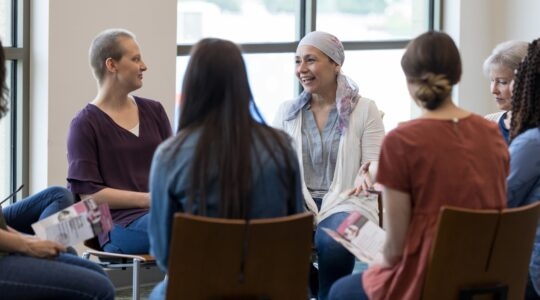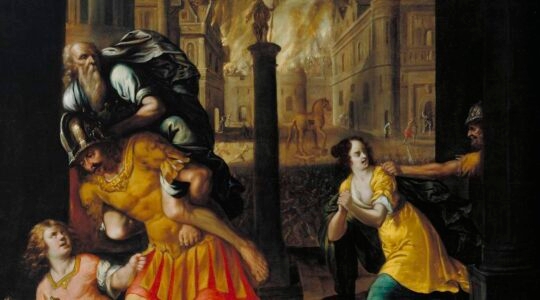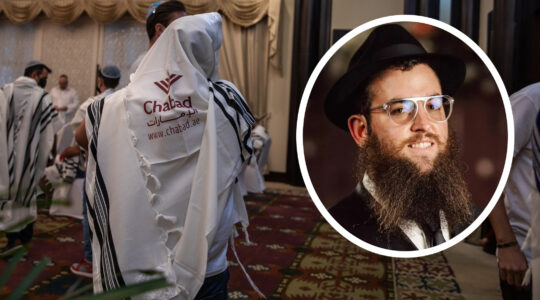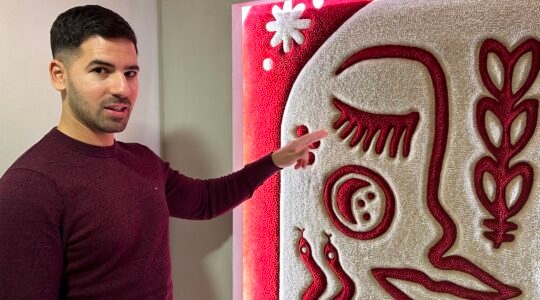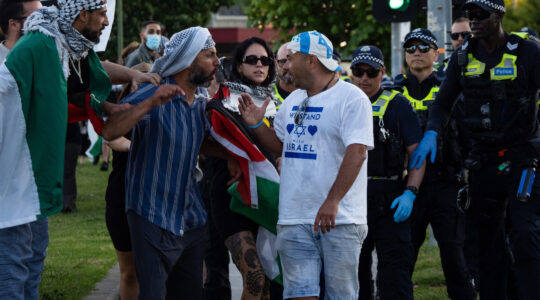SZARVAS, Hungary (JTA) – A friend told me recently about an article he had read proposing that one way to encourage children to eat salad is to drizzle a dab of dressing on top. This way, they would associate healthy eating with something positive rather than the parental harangue, “Because it’s good for you.”
I was reminded of this advice earlier this month when we immersed our two sons, ages 6 and 4, in their first meaningful Jewish experience: five days at the renowned international Camp Szarvas in southeastern Hungary.
On this occasion, though, instead of the hundreds of Jewish youth from across Central-Eastern Europe and the former Soviet Union who gather here each summer at this Jewish oasis, it was Family Week for Hungarian Jewish families with young children.
It was particularly important for my boys to have a positive experience, as my Hungarian wife and I have agreed to raise them with dual identities: Hungarian and Jewish – with a dash of American. And while Agi has held up her end of the deal, I – a tribal agnostic – need to offer up some Jewish substance. Or, as we say in journalism, “show, don’t tell” what being a Jew means to me.
Szarvas delivered with a deft touch. Sandwiched between the fun and games, the boys baked challah, planted flowers “like in a kibbutz” and were introduced to Beit David, the on-campus synagogue that a decade ago was the first built in Hungary from the ground up since the Holocaust.
It was gratifying to see my sons, Miksa and Kende, find their Jewishness a comfortable fit – even bickering over who’d wear the green or white kipah in the kosher dining room. What Agi and I didn’t expect was that even we parents would for the first time feel a sense of belonging to a Jewish community.
From interfaith and Reform to traditional and Modern Orthodox, big-tent Szarvas welcomed us. Hungarian Jews – devastated by the Holocaust, deeply assimilated during the next 40 years by aggressively atheistic communism and today beleaguered by rising far-right sentiment – feel the simple need to connect with fellow Jews.
Especially those of us who have to contend with young children.
“Ideally it would be more religious, to learn more about customs,” says Laszlo Gyorfi, 38, who brought his children, Sara, Benjamin and Daniel. “But even more important than religion is to be together: Jews from different backgrounds but who are in similar situations in their lives. Back home, we don’t have enough time, so we find this connection at Szarvas.”
I myself grew up secular, the son of Jewish refugees from Hungary and Egypt whose families had turned away from religious observance long before my sister and I arrived. It was only when I was 24 and moved to Budapest, my father’s hometown, that my great awakening began: No longer was I an American who happened to be Jewish, but a Jew who happened to be born in America.
Steeping oneself in the fate of Eastern European Jewry – and that of my own family – does that to a guy. As will the occasional glimpse of a swastika, knowing perpetrators and survivors still mill about in a major city like Budapest.
Throughout my travels, I’ll always hunt down the local synagogue for a sense of what Jewish life was like then and is today. It’s a fascination I share with my father, the Jewish emigre. I can respect Judaism, and those who observed it, for being the glue that held a people together for millennia. But for some reason I have never been drawn to religiosity.
So when Agi and I met in Budapest, then discussed having children, a quandary arose: how to raise them not only proud to be Hungarian and Jewish, but recognized by both communities.
For the estimated 15 million Hungarians across the globe, the greatest transmitter of identity is their peculiar language, which they brought from Central Asia 1,100 years ago and preserved within a sea of Slavic tongues. I can’t describe the disappointment in the eyes of Hungarians who have asked me over the years whether my father taught me the language – and told them no.
If you speak like a Magyar, Hungarians accept you as one of their own. Our bilingual boys now do, courtesy of Agi. (I suppose that one day they’ll also learn to curse as creatively as the Hungarians.)
As for the 13 million Jews, who am I to contest millennia of matrilineal descent?
When we moved to New York some years back, Agi generously agreed to convert. We studied together through a course of the Union for Reform Judaism. She studied with a rabbi and was dipped in a mikvah. In the eyes of some, she became a Jew. But it felt mostly symbolic. Beyond her chai necklace, only rarely do we jointly express our Jewishness.
Nevertheless, our sons have developed a sense of Jewishness. And it’s not just all my chatter.
We now live next door to Hungary, in Slovakia, where a tiny Jewish community perseveres. We’ve gone to a Purim party thrown by the country’s lone rabbi, the U.S.-born Chabadnik Baruch Myers.
During Yom Kippur, I took my older son, Miksa, to Bratislava’s one synagogue – down from a prewar total of 19 – where he enjoyed both the mischief of the rabbi’s sons and the wail of the shofar.
Miksa told me one day about a metropolis his class at the local British school was building from cardboard, toilet-paper rolls and other items. As his Irish teacher discussed with Miksa’s assorted Slovak, Western European and Korean classmates what homes, businesses, schools, churches and other structures to include, Miksa says he piped up with: “What about a synagogue?”
So it came as quite a blow last summer when we inquired about the only Jewish summer camp in the capital, run by the Chabad rabbi’s wife. Off the bat, she asked the inevitable: “Is their mother Jewish?” And with that, the Diaspora-wide conversion dispute over “Who is a Jew?” had burst our bubble in Bratislava.
I understand why my family was rejected. Agi was less forgiving, though; a bridge was burned.
Which is why this summer I looked farther afield, to the plains of Hungary four hours away.
I knew Szarvas (pronounced SAR-vash) from reporting I’d done there for JTA over the past decade. The goal of the camp, owned by the Ronald S. Lauder Foundation and run by the American Jewish Joint Distribution Committee is: to connect Jews, bolster identity, develop future communal leaders.
On each visit I had choked up at some point. It wasn’t just that the scores of frolicking Jewish campers, aged 7 to 18, always reminded me of what was lost during the Holocaust.
It was also that after reporting from most of their home countries, I knew this was a rare occasion when they could openly, freely proclaim their Jewishness – and be among those doing precisely the same thing. This is part of what everyone describes as that magical but hard to define “Szarvas feeling.”
I now wanted my two tykes to experience it.
Fortunately, a Szarvas lifer had youngsters like them in mind. Since Szarvas opened in 1990, countless campers had graduated into counselors, or madrichim, and then disappeared into the frenetic real world to work, marry and have children of their own.
While Hungary boasted the largest Jewish community in Central Europe and activities for Jews across the spectrum, young families were a forgotten cohort.
Gyorgy Forgacs spotted this gap four years ago. Among the first Szarvas campers, Forgacs since then has occupied almost every leadership position at the camp, including Israeli folk-dance teacher.
But once he and his wife, Anna, had daughters Flora and Dina, he found himself in the same boat as many other alumnae – communal life didn’t offer much. So they created Family Week.
The JDC agreed to open early and provide meals. Attendees would cover the rest.
“What else could we do?” Forgacs asks. “We had friends who were no longer active and living in their own world. Now we’ve made them active again.”
Four years ago, he and Anna began by mining their phone list; 25 families turned up. This spring, via word of mouth only, they maxed out in four days – 80 families, roughly 320 participants. Another 15 families were disappointed to land on a waiting list.
The five days had something for everybody: song, dance, swimming, pony rides. There were even daily programs for mothers and infants. Then came Friday night and a full slate of Shabbat ritual, but kicked off by a balloon launch. Encouraged to believe in something, God or otherwise, kids wrote their wishes on the balloons before releasing them en masse.
For more cognizant children, Family Week opens eyes.
llona Gyorsok’s twin 6-year-old daughters, Lili and Hajnal, attend a state-run school in Budapest, where each week some classmates step out to attend religious instruction, either Catholic or Protestant. Sometimes they return singing new songs, making her girls just a tad envious.
“Lili asked if everyone in the dining room here is Jewish,” Gyorsok recalls. “Feeling in the majority is something new for them.
“We want them to be happy with their Jewishness,” she adds.
As for our family, this is an annual Jewish tradition we can embrace. Already my boys talk of next summer. They and their newfound friends will become Szarvas campers of the future because the brains behind Szarvas know that children are open to a little Thousand Island or ranch with their Jewishness.
JTA has documented Jewish history in real-time for over a century. Keep our journalism strong by joining us in supporting independent, award-winning reporting.
